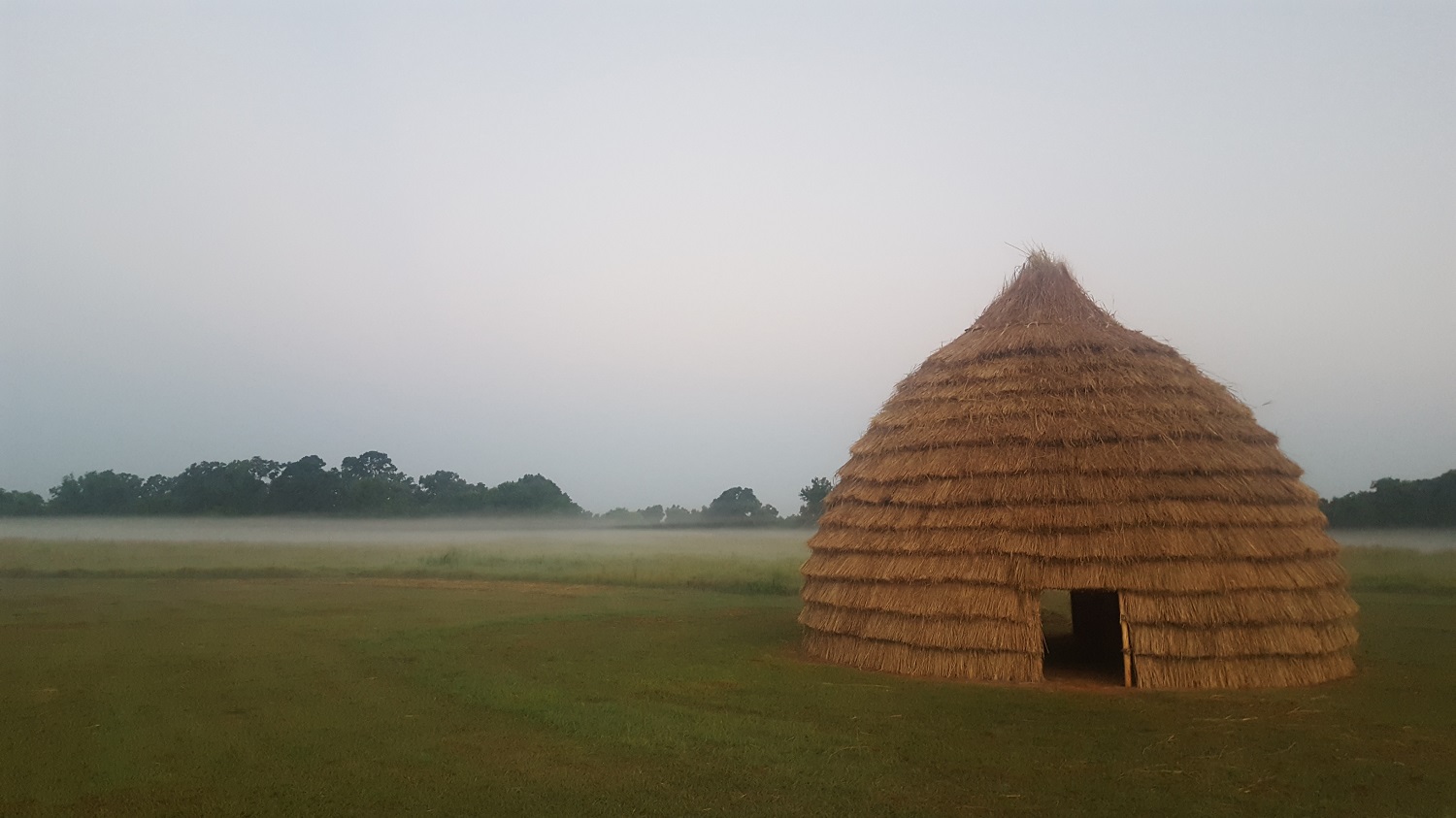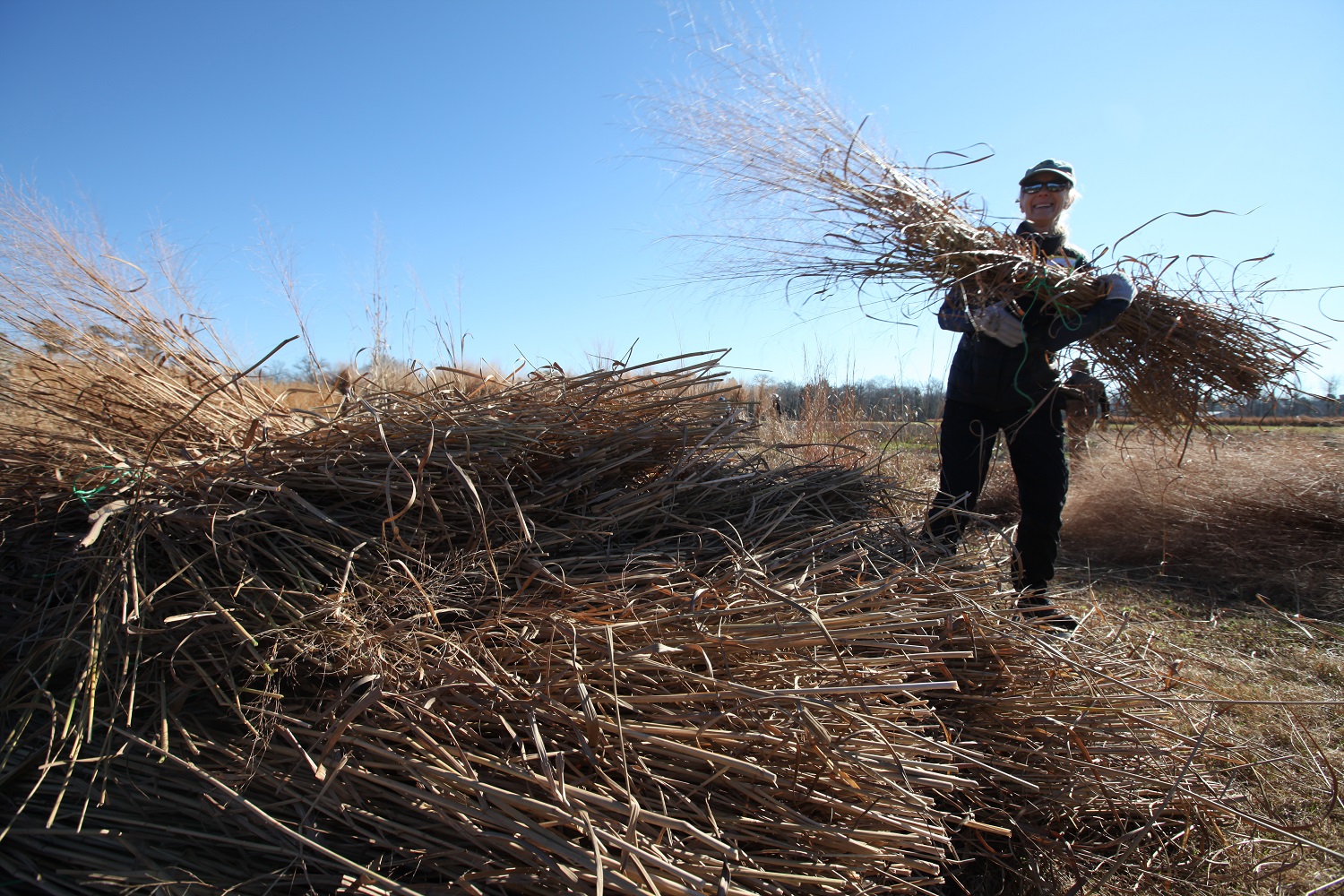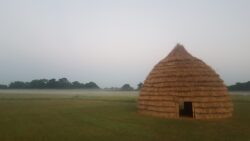“We’re All Sha-Ho Now”
The Caddo grass house, destroyed by a deadly tornado, reopens this fall
Published: August 29, 2022
Last Updated: March 22, 2023

Caddo Mounds State Historic Site
The grass house before the tornado.
“I felt the pressure change, and saw all of the gravel and dirt jump up off of the ground. And then the building exploded. When they pulled me out from under the building, they said there was a hole in my forehead. I don’t remember anything,” Leysath said, nodding toward his friend, Neal Stilley. “He’s one of the ones that pulled me out.”
Stilley was standing just outside of the interpretive center when the force of the storm blew the building to pieces, generating a nightmarish cyclone of flying rebar and cinder blocks. “I looked up and saw the whole building just explode in front of my face,” Stilley said. “And that’s the last thing that I remember. When I came to, I was helping pull Charlie out. That’s when I realized: I’m still alive.” In a matter of seconds, one person on site, a motorist who’d pulled into the Caddo Mounds parking lot to ride out the storm, had been killed and dozens of others were seriously injured. Leysath was among several of the injured who were airlifted to Houston by helicopter. Miraculously, no one inside of the interpretive center was killed.
Leysath and Stilley reflected on these events while taking a break from harvesting switchgrass during a volunteer work day held in Alto this past January. The two have spent many Saturdays this year working alongside dozens of other volunteers, as well as members of the Caddo Nation and representatives of the Caddo Tribal Council, rebuilding the only koo hoot kiwat in the United States. At the grass-harvesting event, Friends of Caddo Mounds President Jeff Williams asked the group of more than forty volunteers to raise their hand if they were at Caddo Mounds on the day of the tornados. More than half of the group raised their hands.

Archeologist Leslie L. Bush helps gather dry grass to rebuild the grass house. Photo by Chris Jay.
Volunteer events were scheduled for mid-July to apply the grass harvested. Williams expects that the koo hoot kiwat will be ready to welcome guests “by September or October,” and Caddo Mounds State Historic Site staffers Anthony Souther and Rachel Galan have planned a year’s worth of educational programming around the themes of “home” and “resilience.”
“The resilience programs are directly related to our sha-ho survivors,” Galan said, using a Caddo word that’s been heard a lot around Alto in the three years since the storm. “We are really working through how to deal with that trauma. State historic sites, parks, and museums are well-situated to provide opportunities to deal with trauma, things like gardening and getting out in the woods.”
Sha-ho is a Caddo word that refers specifically to a member of a community of tornado survivors—not those who have simply seen a tornado, but those who were caught up in the storm together and survived. Stilley told me that the sha-ho group that formed in the wake of the tornados at Caddo Mounds has helped him process what he survived that day, which he said was as traumatizing as anything he witnessed as a combat medic in Vietnam.
“When we get together and do something like this, it’s a healing process,” he said. “We can celebrate the fact that we’ve survived, that we’re thriving as much as we can, and we’re rebuilding the grass house. These gatherings mean the world,” Leysath added, his voice trembling with emotion. “All of us who were there that day are sha-ho now.”
When completed, the grass house will stand approximately nineteen feet tall and measure twenty-six feet in diameter. Inside of the house, visitors will be able to see traditional Caddo basketry and other works created by members of the Caddo Nation. Caddo Tribal Council member Kay O’Neal has been a consistent presence throughout the rebuilding of the grass house. O’Neal oversees the project on behalf of the Caddo Nation in order to ensure that all work is done in accordance with traditional Caddo ways. O’Neal’s cousin, Phil Cross, led construction of the grass house that was destroyed in 2019.
“I’ve been very overwhelmed to see so many people come together not only to support Caddo Mounds, and not only to rebuild the grass house, but to come together with the Caddo Nation as one,” O’Neal said.
The new Caddo grass house will host its first public programs this fall. For updates, follow Caddo Mounds State Historic Site on Facebook or call (936) 858-3218.
Chris Jay is a freelance writer and graduate student currently pursuing a master’s degree in Louisiana folklife and southern studies at Northwestern State University in Natchitoches. He blogs about North Louisiana foodways at stuffedandbusted.com.
